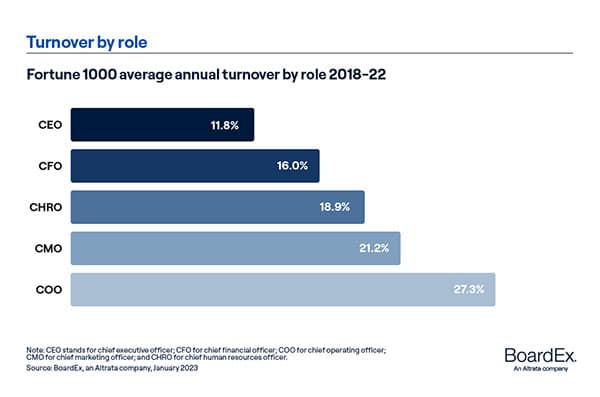Introducing 2023 Spotlight – C-Suite Turnover in the US, a report which examines changes in C-level appointments and exits over the last 5 years. The report analyzes the CEOs, CFOs, COOs, CMOs and CHROs of Fortune 1000 companies and provides a unique perspective on the turnover trends of these positions from 2018 to 2022, with a particular focus on the events of last year.
This report looks into the executives appointed in 2022 and reveals how age and industry impact turnover. The average age at which key C-suite executives are appointed has fallen by nearly four years since 2018.
It finds that among the key five C-suite positions, CEOs and CFOs have the lowest levels of turnover. Over 2018-22, CEOs had the lowest average rate of annual turnover by some distance, followed by CFOs. Given that these two positions exert a critical influence across a business, their arrivals and departures are more momentous and, necessarily, less frequent. Turnover is highest among COOs and CMOs– these higher rates are better understood within the context of the distinctive nature of these two roles.

Other findings include
- COO Turnover was the highest at 27.3% followed by CMOs at 22.2%
- Female executives have a shorter tenure in all 5 positions included in the study
- CEOs and CFOs of health and technology companies are among those with the highest turnover
- The CEO role saw the most year-on-year increase in turnover, jumping up three percentage points
- An examination of 2022 appointments and how senior executive recruitment may develop.
How does the report define turnover and who is included?
The rate of turnover can be defined as the proportion of employees that leave an organization during a set period, calculated annually. For this report, we include anyone who has left their role, regardless of the circumstance – be it planned, forced or due to restructuring following a merger or acquisition (M&A) – or whether they have stayed with or left the company.
This report leverages BoardEx’s unique and proprietary Global Leadership Database, which covers board and non-board members, C-suite executives, senior leaders and professional advisers. The database contains more than 2 million profiles of public, private and not-for-profit organizations and the 1.6 million people who work for them.
Maya Imberg is the Head of Thought Leadership and Analytics at Altrata. She is responsible for spearheading the company’s thought leadership efforts and overseeing its analytics and predictive modeling services commissioned by clients. She joined Wealth-X in 2016 as Director of Custom Research responsible for secondary research, data analytics and branded content. Maya has over fifteen years of experience in research, spanning market research, macroeconomics and financial services. Prior to joining Wealth-X, Maya held a variety of consultant and economist roles at the Economist Intelligence Unit and spent a number of years working for Datamonitor’s Financial Services practice. Maya holds an undergraduate and MSc degree in economics and comparative politics from the University of Pennsylvania and London School of Economics respectively.